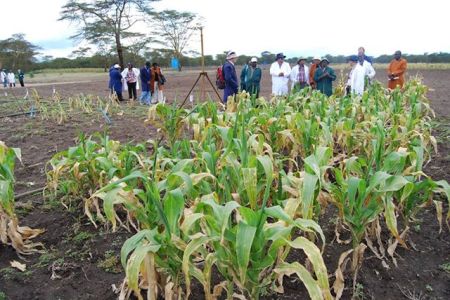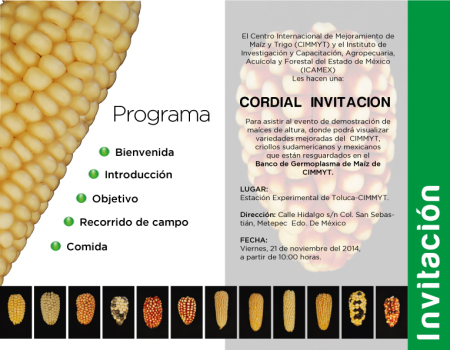- Ok here goes, there’s a week’s work of Nibbles we’ve got to catch up on.
- World running out of chocolate! Tell that to Cologne.
- Yeah well I prefer tea to cocoa.
- Greenpeace: “Smart breeding” will save us, not GMOs. Breeders: All breeding is smart.
- Guess the world’s biggest cash crop. Yeah, that one.
- Alas, it’s not included in the recent strategy for conserving medicinal plants. Not that it would need conserving.
- The domestication of the world’s biggest crop, period. Deconstructed. And if you want to drill down.
- And of the world’s biggest fruit.
- And of the world’s biggest pet.
- And of the world’s most difficult to eat vegetable.
- Root “vegetables” made simple. Because winter.
- And why you must eat your veggies, including the difficult ones.
- Videos on Kew’s monocot database and on the renovation of another famous herbarium.
- The real Johnny Appleseed.
- But you too can save seeds, just like Johnny.
- But don’t forget to safety duplicate, like CIP has done, at Embrapa.
- And this shows you what those seeds can look like.
- You don’t necessarily need seeds to save plants, though.
- Mapping fallen fruit. Because we can.
- Road trip!
- Boat trip!
- Selected Techniques in the Art of Agriculture. From French to Turkish to Arabic. One of many nifty agriculture-related resources in the World Digital Library.
- Oh yeah, the IUCN World Parks Congress has been on and its all over the intertubes. Including with neat visualizations, natch.
- How many of the species in the COMPADRE database of plant demography information are in protected areas? How many are crop wild relatives? I need an intern.
Maize field day in Mexico
Dr Denise Costich, head of the CIMMYT maize genebank (MGB) sent out a very compelling invitation a couple of days back:
Attached is the official invitation to our field day, to be held next Friday, 21 November, starting at 10:00 AM at the Toluca Station (please note the change of date). We are showcasing our beautiful materials from the high altitude Andean germplasm that, up to now, the MGB has had great difficulties in regenerating here in Mexico. We also included a demonstration plot in our nursery, featuring long forgotten genetic pools developed at the Toluca Station in the 80s and 90s, as well as, popcorns, cacahuacintles, and other landraces from the region. We are targeting the smallholder farmers from areas around 2600 masl and above. We couldn’t have done this without funding from the Global Crop Diversity Trust and ICAMEX. We also thank the Toluca Station Manager, Fernando Delgado, for his great support, interest, and encouragement. Thanks also to Hans Braun, who extended an invitation to the “maiceros” of CIMMYT to plant at this wonderful station… I’m sure I have missed people who might be interested in attending the field day. You are welcome to forward this invitation to them. However, everyone, please RSVP, so that we have enough food and catalogs!
It sounds like great fun, and I wish I could go, but I can’t. Maybe you can?
Brainfood: Basil resistance, Maize quality & drought, Benin sorghum, Swedish farm size, E European grapevives, Lebanese olives, Brazilian sheep, Sudanese cattle, Egyptian bean rhizobia, Barley origins, Intercropping
- Selecting basil genotypes with resistance against downy mildew. Only the exotic basils were any good. I will resist the temptation to make Fawlty Towers jokes.
- High grain quality accessions within a maize drought tolerant core collection. Not so much a core collection, rather a set of local and exotic drought-tolerant varieties put together in the former Yugoslavia. Some of which turn out to have decent quality too.
- Diversity, genetic erosion and farmer’s preference of sorghum varieties [Sorghum bicolor (L.) Moench] in North-Eastern Benin. Climate change, poor soils and striga are the main problems, according to farmers, and none of their current varieties will help much, apparently, which is why they are disappearing.
- Effects of Farm Size and On-Farm Landscape Heterogeneity on Biodiversity—Case-Study of Twelve Farms in a Swedish Landscape. Small farms = heterogeneous farms = biodiversity-rich farms.
- Identification and characterization of grapevine genetic resources maintained in Eastern European colletions. SSR revealed that of 1098 mainly Vitis vinifera accessions, 997 were indigenous to E. Europe, 101 were Western European cultivars, hybrids, rootstocks and new crosses; the 997 accessions were actually 658 unique cultivars, 54% of which were maintained in the countries of origin only.
- Extent of the genetic diversity in Lebanese olive (Olea europaea L.) trees: a mixture of an ancient germplasm with recently introduced varieties. Three genetic groups around the Mediterranean, most Lebanese material typical of the eastern group; monumental trees similar to Cypriot varieties. In other news, there’s a World Olive Germplasm Bank of Marrakech.
- Application of microsatellite markers for breeding and genetic conservation of herds of Pantaneiro sheep. Evidence of inbreeding means a proper genetic management scheme needs to be designed and implemented.
- Historical demographic profiles and genetic variation of the East African Butana and Kenana indigenous dairy zebu cattle. The only indigenous African dairy breeds, apparently, but with distinct genetic histories despite their similar distribution in Sudan and dairy use.
- Phylogenetic multilocus sequence analysis of native rhizobia nodulating faba bean (Vicia faba L.) in Egypt. Three species, and evidence of horizontal gene movement among them.
- Transcriptome profiling reveals mosaic genomic origins of modern cultivated barley. The Fertile Crescent and Tibet.
- Improving intercropping: a synthesis of research in agronomy, plant physiology and ecology. You can breed for it. Among other things.
Fighting the Ebola of maize
Speaking of Denise Costich, she recently visited CIMMYT’s Global Maize Program in Africa and shared this photo — frightening, and yet also hopeful, as she explains below:

Maize Lethal Necrosis (MLN) is being called the “Ebola of maize” — it is actually a “perfect storm” of two viruses hitting the plants at the same time, carried all over the place by insect vectors… It’s hitting East Africa really hard right now, and CIMMYT scientists are screening as much germplasm as they can, in the search for resistance genes. Here you see an example of a “moderately tolerant” line. To the left of that plot, you can see another line that was completely decimated…
I’m featuring Denise a lot lately to make up for the fact that I forgot to take a photo of her to include in the mosaic of CGIAR genebank managers :)
Brainfood: Enset & cattle, Evolution Canyon, Indian spices, Bohemian fruit rhapsody, ILRI forage genebank, Wild sunflower, Agroecology, Holistic hazelnuts, Culture & conservation, Salty broomcorn, Fancy mapping, German cherries, Ethiopian barley nutrients
- Sidama Agro-Pastoralism and Ethnobiological Classification of its Primary Plant, Enset (Ensete ventricosum). The Sidama feed the high-protein parts of enset to cattle and then get their protein from milk. Seems a roundabout way of going about things but I guess they know best.
- Evolution of wild barley at “Evolution Canyon”: adaptation, speciation, pre-agricultural collection, and barley improvement. One-stop shop for researching evolution of a crop wild relative.
- Spices and Condiments: Status of Genetic Resources and Setting Priorities for Introduction in India. National Bureau of Plant Genetic Resources is on the job, collecting at home and acquiring from genebanks abroad.
- Inventory and conservation of fruit tree landraces as cultural heritage of Bohemian Forest (Czech Republic), indicators for former settlements of ethnic minorities. That would mean Germans. No word on whether the database has been cross-checked with that of BLE-IBV. Interested in the topic of European landraces in general? Try this from Bioversity.
- Forage Diversity: An Essential Resource to Support Forage Development. ILRI’s genebank deconstructed.
- Wild Sunflower Species as a Genetic Resource for Resistance to Sunflower Broomrape (Orobanche cumana Wallr.). Pretty much all the perennial species have resistance, and many of the annuals. Thank goodness for the USDA collection, eh?
- Agroecological Research: Conforming — or Transforming the Dominant Agro-Food Regime? Bit of both? Is that such a bad thing?
- A multidisciplinary approach to enhance the conservation and use of hazelnut Corylus avellana L. genetic resources. Holistic, even.
- The Cooked is the Kept: Factors Shaping the Maintenance of Agro-biodiversity in the Andes. Keep your culture, keep your crop diversity.
- Response of broomcorn millet (Panicum miliaceum L.) genotypes from semi arid regions of China to salt stress. 39 out of a core collection of 195. Result!
- Vital Signs: Integrating Data To Visualize the Human, Agriculture, and Nature Nexus. Sounds promising enough an effort to bring together livelihoods, production and environmental data, but when you go to the website (for Tanzania in this case), all you get is a bunch of admittedly very pretty pdf maps.
- Phenotypic and genotypic characterization in the collection of sour and duke cherries (Prunus cerasus and ×P. ×gondouini) of the Fruit Genebank in Dresden-Pillnitz, Germany. …give different results. If I had a dollar…
- Genome-wide association mapping of zinc and iron concentration in barley landraces from Ethiopia and Eritrea. There are QTLs. Now what?
